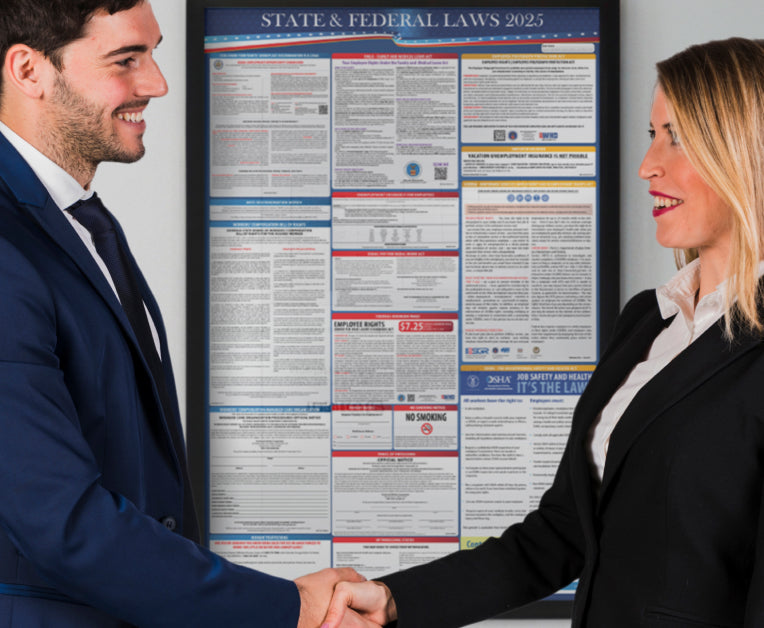
How HR Teams Can Simplify Labor Law Poster Management
Human Resources teams face the ongoing challenge of keeping organizations compliant with labor law poster requirements. Federal and state laws mandate that specific workplace notices be displayed prominently to inform employees of their rights. Non-compliance can lead to fines, legal exposure, and operational disruptions.
Managing these posters across multiple locations, remote teams, or hybrid setups can be overwhelming. HR teams need practical solutions to ensure that every employee has access to up-to-date labor law notices.
In this blog, we’ll explore strategies HR teams can use to simplify labor law poster management, minimize risk, and maintain compliance effortlessly. For guidance on OSHA-specific compliance, see how to avoid OSHA fines for missing workplace posters. For digital distribution options, check out is it legal to email labor law posters to employees.
Why Labor Law Posters Are Essential for HR Teams
Labor law posters are more than legal obligations—they serve as educational and protective tools for employees:
- Inform Employees: Posters educate staff on wage rights, workplace safety, anti-discrimination policies, and leave entitlements.
- Reduce Legal Risk: Up-to-date posters help HR mitigate the risk of fines, penalties, and audits.
- Demonstrate Compliance: Visible and current posters show employees and regulators that the organization prioritizes legal and ethical standards.
- Support Organizational Culture: Posters promote transparency and reinforce the company’s commitment to workplace rights.
HR teams are responsible for ensuring that all employees, regardless of location, have access to these important notices.
Common Challenges in Labor Law Poster Management

HR teams face several obstacles when managing labor law posters:
- Frequent Updates: Federal and state labor laws change regularly, requiring posters to be updated multiple times a year.
- Multiple Locations: Organizations with offices, warehouses, and remote employees need consistent compliance across all sites.
- Hybrid Workforce: Remote employees may not have physical access to posters, requiring digital distribution solutions.
- Manual Tracking: Keeping track of which posters are current and where they are displayed can be time-consuming and prone to errors.
These challenges make labor law poster management a complex task, but HR teams can simplify the process with the right approach.
Centralized Poster Management
Centralizing poster management is a key strategy for HR teams to streamline compliance.
1. Use a Single Source for Posters
Instead of sourcing posters individually from multiple providers, HR teams should use a single, reliable source that provides all federal and state labor law posters in one package. This ensures:
- Accuracy of content
- Timely updates for new laws
- Consistency across locations
A professional provider like StateLaborPoster.com offers comprehensive coverage for all labor law requirements.
2. Maintain a Central Repository
Create a central repository—digital or physical—where all labor law posters are stored. Benefits include:
- Easy access for HR staff and employees
- Streamlined updates when laws change
- Simplified auditing and record-keeping
Digital repositories can also accommodate remote or hybrid employees who cannot access physical posters.
Automatic Updates Through Subscription Services
Subscription services are a game-changer for HR teams. They provide:
- Automatic Federal and State Updates: Posters are updated as laws change, eliminating the need for manual tracking.
- Bundled Compliance: Access to all required labor law posters in one package, including OSHA notices.
- Digital Delivery: Posters can be emailed or accessed online, ensuring compliance for remote employees.
- Audit Documentation: Keep records of updates and distribution to demonstrate compliance during inspections.
Learn more about email distribution and remote compliance in is it legal to email labor law posters to employees.
Physical Posting Best Practices
Even with digital access, physical posters remain necessary for on-site employees. HR teams should ensure:
- Posters are placed in high-traffic areas, such as break rooms, near time clocks, or entrances.
- Legibility is maintained—posters should be readable, clean, and undamaged.
- Posters are updated promptly when laws change.
For organizations with multiple offices, assigning local HR representatives or managers to oversee poster locations ensures compliance across sites.
Digital Distribution for Remote and Hybrid Teams
Hybrid and remote employees require special consideration:
- Email Notifications: Send updated posters directly to employees.
- HR Portals: Make posters available on company intranet or internal HR platforms.
- Acknowledgment Tracking: Require employees to confirm receipt and understanding of posters.
Digital distribution ensures that all employees, regardless of location, have access to legally required information. For a deeper guide, see how labor law posters differ for remote and hybrid workers.
Streamlining Compliance Across Multiple States
For multi-state organizations, poster management can be particularly complex:
- Federal labor law posters apply nationwide.
- State-specific posters must be displayed in each jurisdiction where employees work.
- Some cities or counties have additional local requirements.
A subscription service provides all required posters for each state, simplifying management and ensuring consistency across locations.
Record-Keeping and Documentation
HR teams must maintain documentation to demonstrate compliance:
- Logs of poster locations and display dates
- Records of digital distribution and employee acknowledgment
- Archived versions of prior posters to track updates
- Notes from internal audits to ensure ongoing compliance
Proper record-keeping protects the organization during audits and inspections.
Educating Employees About Labor Law Posters
Posters are most effective when employees understand their purpose. HR teams can enhance effectiveness by:
- Conducting brief training sessions on employee rights
- Highlighting key poster information during onboarding
- Providing digital guides or FAQs alongside posted notices
Employee awareness reduces risk, reinforces transparency, and fosters trust in HR processes.
Avoiding Common HR Pitfalls

HR teams often face pitfalls in poster management, including:
- Assuming one set of posters covers all employees – Different states require different content.
- Ignoring updates – Laws change frequently; outdated posters are non-compliant.
- Neglecting remote staff – Remote employees must have access to notices through digital means.
Professional subscriptions and centralized management eliminate these common errors.
Leveraging Professional Services
Professional labor law poster providers like StateLaborPoster.com offer:
- Bundled federal and state posters
- Automatic updates for legal changes
- Physical and digital versions for all employees
- Record-keeping support for audits
Using such services frees HR staff to focus on core responsibilities while ensuring compliance is maintained effortlessly.
HR teams play a crucial role in maintaining labor law compliance. Simplifying poster management involves:
- Centralizing poster sources
- Using subscription services for automatic updates
- Combining physical and digital postings for all employees
- Maintaining thorough documentation
- Educating staff about their rights
By implementing these strategies, HR teams can save time, reduce risk, and ensure consistent compliance across all locations and work arrangements.
For professional solutions that streamline labor law poster management, visit StateLaborPoster.com.
Proper poster management is not just a regulatory requirement—it reflects your commitment to employee rights, workplace transparency, and organizational integrity.


